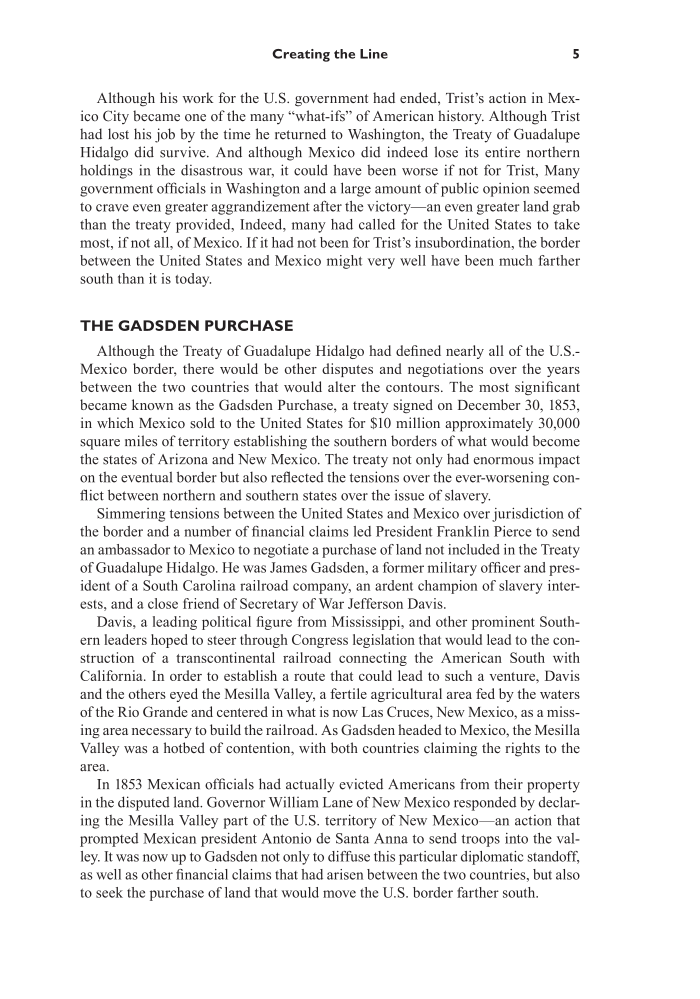Creating the Line 5 Although his work for the U.S. government had ended, Trist’s action in Mex- ico City became one of the many “what-ifs” of American history. Although Trist had lost his job by the time he returned to Washington, the Treaty of Guadalupe Hidalgo did survive. And although Mexico did indeed lose its entire northern holdings in the disastrous war, it could have been worse if not for Trist, Many government officials in Washington and a large amount of public opinion seemed to crave even greater aggrandizement after the victory—an even greater land grab than the treaty provided, Indeed, many had called for the United States to take most, if not all, of Mexico. If it had not been for Trist’s insubordination, the border between the United States and Mexico might very well have been much farther south than it is today. THE GADSDEN PURCHASE Although the Treaty of Guadalupe Hidalgo had defined nearly all of the U.S.- Mexico border, there would be other disputes and negotiations over the years between the two countries that would alter the contours. The most significant became known as the Gadsden Purchase, a treaty signed on December 30, 1853, in which Mexico sold to the United States for $10 million approximately 30,000 square miles of territory establishing the southern borders of what would become the states of Arizona and New Mexico. The treaty not only had enormous impact on the eventual border but also reflected the tensions over the ever- worsening con- flict between northern and southern states over the issue of slavery. Simmering tensions between the United States and Mexico over jurisdiction of the border and a number of financial claims led President Franklin Pierce to send an ambassador to Mexico to negotiate a purchase of land not included in the Treaty of Guadalupe Hidalgo. He was James Gadsden, a former military officer and pres- ident of a South Carolina railroad company, an ardent champion of slavery inter- ests, and a close friend of Secretary of War Jefferson Davis. Davis, a leading po liti cal figure from Mississippi, and other prominent South- ern leaders hoped to steer through Congress legislation that would lead to the con- struction of a transcontinental railroad connecting the American South with California. In order to establish a route that could lead to such a venture, Davis and the others eyed the Mesilla Valley, a fertile agricultural area fed by the waters of the Rio Grande and centered in what is now Las Cruces, New Mexico, as a miss- ing area necessary to build the railroad. As Gadsden headed to Mexico, the Mesilla Valley was a hotbed of contention, with both countries claiming the rights to the area. In 1853 Mexican officials had actually evicted Americans from their property in the disputed land. Governor William Lane of New Mexico responded by declar- ing the Mesilla Valley part of the U.S. territory of New Mexico—an action that prompted Mexican president Antonio de Santa Anna to send troops into the val- ley. It was now up to Gadsden not only to diffuse this partic u lar diplomatic standoff, as well as other financial claims that had arisen between the two countries, but also to seek the purchase of land that would move the U.S. border farther south.
Document Details My Account Print multiple pages
Print
You have printed 0 times in the last 24 hours.
Your print count will reset on at .
You may print 0 more time(s) before then.
You may print a maximum of 0 pages at a time.









































































































































































































































































































